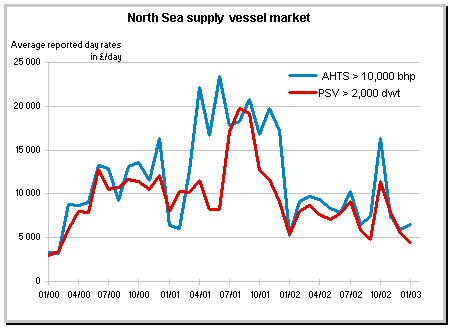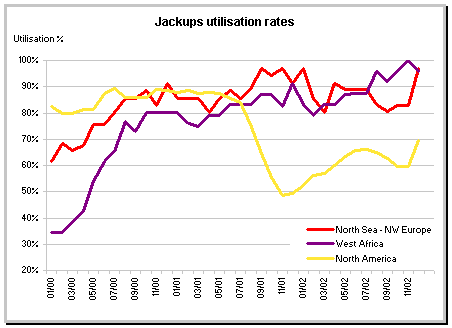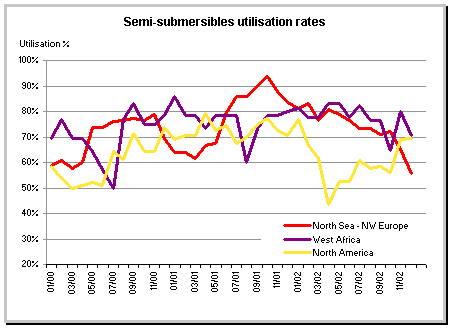
|
The offshore and specialised ships markets
in 2002
|
| |
Offshore support vessels
North Sea
U.S. Gulf
West Coast Africa
Brazil
Caspian Sea
Subsea Construction / Surface systems
Drilling
Seismic market
Cable laying market
Prospects
|
In general we've seen a slow down and at best
a steadiness in the offshore industry sectors. The high oil price throughout the year did not
boost the exploration & production investments, nor did the Iraki crisis really impact the
supply and demand balance.
Consolidations, mergers and acquisitions have continued in all industry branches. We have
witnessed the giant Conoco ' Phillips merger and in the offshore and engineering /
construction side we saw the formation of Aker-Kv'rner as well as the Keppel Fels takeover of
Verolme Botlek.
Pushing into deeper and deeper waters, the technological differences in the various areas are
slowly being erased and we see the early beginning of a market globalisation with a few key
players for each of the offshore markets.
|
| Offshore support vessel |
|
|
The Anchor Handling Tug / Supply (AHTS) and the
Platform Supply Vessel (PSV) fleet utilisation continued to drop in the main markets throughout
most of the year. Lower drilling activities and delivery of a number of uncommitted
newbuildings, have both contributed to the market imbalance.
A general trend is continued in so far that oilfields are developed further from the coast, in
deeper waters and in areas outside the established offshore field infrastructures. This creates
a demand for a further evolution of the sophisticated and self-sustaining multipurpose modern
vessels.
Groupe Bourbon worked their way into the North Sea with a controlling stake in Havila Supply
ASA with Saevik, Ulstein and Aker as substantial allies. Havila will as a result obtain a
better foothold in West-Coast Africa as well as in Brazil. An example of this, is the Petrobras
award to Island Offshore II, in which Groupe Bourbon owns 51% of the contract for the UT722L
'Havila Crown'. The vessel, being the first of three newbuilding vessels of this kind, will
be operated by Havila and Delba Maritima.
China is further substantiating its share of the newbuilding market of offshore support vessels
for owners such as Vroon and Sealion.
|

|
| North Sea |
|
|
The spot market never gained the expected summer
momentum this year, but peaked in October with large AHTS obtaining charter rates up to $55,000
per day. The low drilling activities, combined with a constant drip feed of PSV / AHTS
newbuildings and a steady supply of sublet tonnage, has seen a market paying in general below
the $20,000's per day.
Up to now an almost static stand-by / rescue
market is about to evolve from a one-vessel-per-rig into a multipurpose field support vessel
scenario, that offers area contingency for several fields simultaneously. The design is a safe,
fast and environmental friendly offshore unit with ROV facilities, helideck and fast MOB's.
Simon M'kster Shipping AS, Norway, was awarded a sound 8 years firm Statoil contract upon
which the above will be constructed.
The North Sea shipyards' continuous trend towards building hulls in low-cost areas with home
outfitting continues. The barrier of hull building is gone, consequently, repair yards in
Eastern Europe are entering the scene taking a share of the newbuilding market.
|
| U.S. Gulf |
|
|
The charter rates in this market were on average
about 20 % lower than in 2001. The fleet utilisation dropped and owners reported lower
earnings, some were even forced to lay up old tonnage in order to balance the market.
U.S. Gulf field developments are also increasingly moving into deeper water. Many old vessels
are being traded and others are idle in need of several $100,000's input per ship in order to
comply with classification requirements. The market is in need of a continuous fleet renewal in
order to be able to offer modern services to demanding oil companies. Several market contenders
rise to the challenge:
-
Hornbeck Offshore Services LLC
continues expanding with 4+ 4 options DP2 Offshore Support Vessels being built at
Leevac Industries.
-
Otto Candies took delivery of DP2
Offshore Support Vessels from Bender Shipyard and from the new and interesting Houma
Fabricators, acquired by the Dutch shipyard De Hoop.
-
Rigdon Marine contracted 10 OSVs at
Bender Shipyard representing the largest single offshore order in the history of USA.
-
Tidewater placed an order for four
PSVs at Bollinger Shipyards.
Large U.S. owners are building vessels in the
U.S.A. in compliance with the Jones Act and the surplus tonnage is attempting to trade in the
offshore markets of Brazil, Africa and Mexico.
|
| West Coast Africa |
|
|
The general West Coast Africa market proved
strong enough to absorb tonnage coming from the North Sea / U.S. Gulf, due to the high level of
production development activities offering some long term opportunities.
Esso Exploration Angola, a local subsidiary of ExxonMobil, awarded a shipping services contract
to Sonasurf, the joint venture between Sonangol and Surf. The duration of the contract was 5
years firm, but included options for two more 5-year periods. The contract provides for it to
define and manage all the shipping resources required for the development and operation of
production fields on block 17.
The African West Coast subsea market has further evolved throughout the last years, stretching
from the laying of flexible and rigid pipes from heavy crane barges, to today's grown market
with deep sea trends. The large spread moored barges are slowly being replaced by modern
vessels in line with any international versatile tonnage.
An answer to these as well as to international requirements is Surf's newbuilding 'Athena'
a VS4501 MPSV delivered from Keppel this year, equipped with DP2, accommodation for 82 persons,
FI-FI 2, under-deck capacities, anti-pollution equipment, a high reaching 100t crane, moon-pool
and a helideck in order to do a larger scope of work.
Large support vessel owners such as Farstad and GulfMark are eyeing this evolving market and
have begun bidding for tenders in competition with the players already present.
|
| Brazil |
|
|
The Brazilian deep offshore market has been less
subjected to the overall markets, despite a high domestic demand for oil, and as such, enjoys
an uninterrupted and steadily progressing E&P programme. This domestic market prevents an
open access for international offshore tonnage, in the form of national flag requirements
briefly outlined as follows:
-
Heavy taxes on flagging foreign
vessels into Brazil to qualify for tenders.
-
By law, local tonnage has the first
right to any Brazilian tender and as such, the tendering business is open to the
public. If local tonnage doesn't comply with the requirement, foreign tonnage can,
through local co-operating partners or subsidiaries, obtain an operating licence for
renewable two-year periods.
The motivation of building in Brazil is direct
qualification to work in Brazilian waters, long-term contracts from Petrobras, a high demand
for sophisticated tonnage and beneficial financing. Instant access to the market is also of
importance as owners with vessels under construction in Brazil are allowed to market their
foreign built front-runner during the entire construction period.
Local shipyards have been reactivated thanks to participations taken by experienced European
and Far Eastern shipyards.
Some of the market players that have been taking advantage of the Brazilian market: Solstad
Offshore ASA and District Offshore ASA joining forces forming Norskan Offshore Ltda. They have
2 x UT755L under construction at Aker Promar, where GulfMark's UT719-2 and UT755L are also
under construction.
It is unlikely that this market will reach a saturation point in the nearest future.
|
| Caspian Sea |
|
|
The Caspian El Dorado in the offshore oil
activities resulted this year in BUE taking delivery of a tailor-made, shallow draft AHTS
icebreaker built at Ulstein Verft. The same owner also bought and now operates the AHTS 'Stirling
Iona' and 'Stirling Jura' in this region.
Due to the narrow river / canal systems, modulated offshore units are brought in by oil
companies for assembly in the Baku area and the local competence are struggling to get in on
the technical side. We foresee more newbuilding orders for these waters in the time to come.
|
| Subsea Construction /
Surface Systems |
|
|
The demand for subsea construction was less
affected by the general industry slow down than expected. Whilst North Sea activity was on the
low side, West Africa has been literally pulling up the market. Effectively there are numerous
surface systems under construction or installation. We also notice a world wide increase in
number of projects being tendered, which leads us to believe that this industry will not suffer
from a lack of demand in volume.
On the negative side, most of the industry players have been hit by lower margins and the risk
associated to turnkey lumpsum projects, thus we saw the creation of Subsea 7, the result of
Halliburton Subsea and DSND merging their subsea construction vessels into one fleet.
Contractors are also consolidating their fleet by trying to get rid of their older tonnage and
upgrading their existing vessels.
In small / medium size construction vessels segment, contractors are submitted to the
competition of the new versatile tonnage ordered by conventional supply shipowners.
A construction worth noticing is the 'North Sea-type Light Well Intervention Vessel' being
built at Aker Brattvaag. The new UT 737-L design will be delivered in July 2003. The exhaustive
efforts of streamlining the difference in regulations between the Maritime Administration (NMD)
and the State Department of Oil (NPD) eventually resulted in the long awaited DnV class
notation 'Well Intervention Unit Class 1'. The vessel's main features are 106 x 21 m,
compact azipod main propulsion, DP3, accommodation for 84, helideck and a 100t heavy
compensated crane. The $ 68 m vessel is being built on speculation for Island Offshore V.
The general demand for big surface projects proved strong enough to keep the main EPC
contractors busy throughout the year. Some of the main interesting events and trends to notice
in 2002 are amongst others:
-
The further consolidation of the
market: Saipem took full control of Bouygues Offshore. Renaming it Saipem SA, they
dramatically increased their engineering capacity. Together they were awarded the
contract for the construction of the 2 million bbls 'Ehra FPSO' for Exxon
Nigeria.
-
The withdrawal of Keller Brown &
Root and ABB Oil & Gas as prime contractors from this specific market.
-
The emergence of China as an FPSO hull
builder.
-
The increase of South Korea's market
share in this sector: Hyundai firmed up the contract for the construction of the
Exxon Angola 2 million bbls FPSO and DSME (Daewoo) secured another contract for a TLP
(tension leg platform) for Exxon Angola Kizomba B field.
We expect the engineering and contracting
companies to remain rather busy next year.
|
| Drilling |
|
|
The general activity and fleet utilisation have
overall been low throughout the year. The markets hardest hit are the Gulf of Mexico and the
North Sea with numerous idle units. The latter saw UK raise corporation tax by 10 % thus
further reducing the oil companies' expected return in this high-cost area. Better off
markets are the West Coast Africa, Australia, Indonesia, Malaysia and the Mediterranean.
Some of the downturn can possibly be blamed on the recent years' consolidation costs among
the oil companies, reducing the drilling budgets. Concerns about the world economy, the Iraki
crisis and its implications for oil and gas prices, are other factors causing companies to be
cautious. This trend is also reflected in the low level of newbuilding activities; on the other
hand, the sale and purchase market has been very active with the following relevant
transactions:
-
Ensco made a cash and stock offer and
took over Chiles Offshore's five modern 300 feet + jack-ups.
-
Diamond Offshore bought the $ 68.5 m
semi-submersible 'West Vanguard' from Smedvig ASA and the $ 65 m semi-submersible
'Omega' from Transocean.
Instead of going for new constructions,
contractors should carry on refurbishing and upgrading their existing fleet so as to maintain
their access to the market at affordable costs, in combination with a drought of long term
contracts in the drilling market.
|


|
| Seismic market |
|
|
Few opportunities have arisen in this market as
the volume demand for 2D and 3D data also suffered from the general exploration slowdown.
The 'CGG Mistral' conversion was completed and the vessel was re-delivered in 2002, being
the first-of-it's-kind having triple-screw propulsion. She was fitted with the new CGG solid
streamers system. Unfortunately she sunk in December. CGG also acquired a 7.51 % stake in
troubled PGS, which hints at a further consolidation in this market.
Western Geco continued this year to sell old tonnage. Some of these were the ex-seismic vessels
'Western Atlas' and the previously flooded 'Geco Sapphire', both being sold out of the
seismic market and therefore at prices quite lower than the initial asking price.
|
| Cable laying market |
|
|
The demand remained close to zero throughout the
year, consequently Global Crossing's attempt to dominate the market for high speed data
communications was followed by the $ 12.4 bn bankruptcy. Hutchison Whampoa and Singapore
Technology should manage to pick up the remains in a deal totalling $ 750 m.
Another 8 newbuildings and 1 conversion vessel were delivered into the market, whereas
charterers have released as many as possible. Some vessels are returning to the offshore
market, amongst these are the 'Ocean Commander', 'Toisa Conqueror' and the 'Maersk
Forwarder'. Others were sold for subsea purposes: Sealion bought the 'Fresnel' from FT
Marine and Torch Offshore bought the 'Wave Alert' from Global Marine. The latter vessel
will be fitted with a 125 ton crane. A few other vessels are still on-hire, but most are
laid-up or idle.
The low level of activity in the repair and maintenance sector did not compensate the collapse
of the laying activity.
|
| Prospects |
|
|
Drilling activities will remain low in the first
half of 2003, but could pick up towards the second half of the year in line with the increase
in oil companies' exploration budgets. The seismic contractors should also benefit from this
rebound. We expect to see a further materialisation of new markets in the regions of the
Caspian Sea and the Sakhalin Islands. Following the change of regulations, we hope to see
tenders for FPSOs in the Gulf of Mexico in 2003.
The supply vessel market has evolved over the last 10 years from being an exception in the
North Sea, to become one of major importance in multiple geographical areas. Most of these
areas have developed into deep water projects and the support vessel designs enabling E&P
support in these environments are beginning to set an international standard.
The market globalisation will cause an easier shifting of supply vessel tonnage between the
geographical markets and the natural consequence will be a further consolidation in this
sector. As such, we also expect the various segments to move deeper into correlated cycles, a
bit like most other international shipping markets. This is of course with the exception of the
protected offshore areas.
The combination of the above could further impact the associated markets and hopefully last
long enough to absorb and to balance out the numerous supply vessel newbuildings delivered over
the last two years.
Operators of subsea and pipe-laying vessels will have to pursue their fleet downsizing as
demand in 2003 will not meet expectations.
When the supply and offshore vessels market eventually regains balance, traditional builders
should be alerted to cope with the pressure from the emerging builders from China, who have set
their minds to take a significant stake of the newbuilding market.
|
Shipping and Shipbuilding Markets in 2002
I N D E X
|